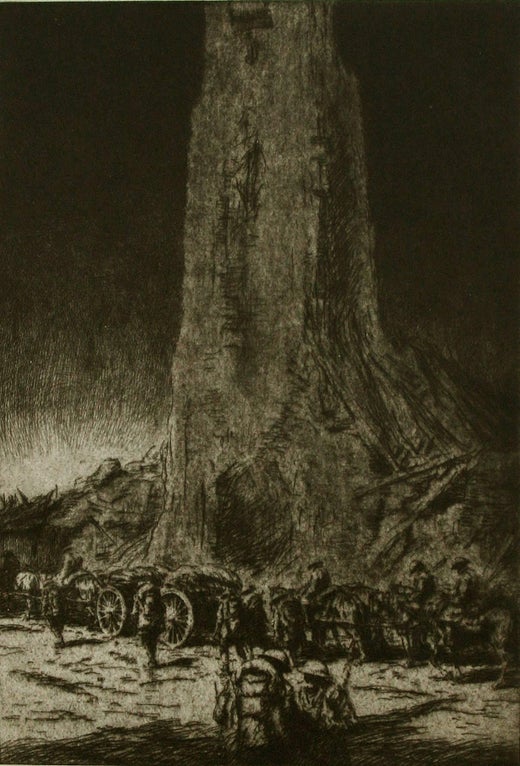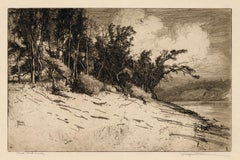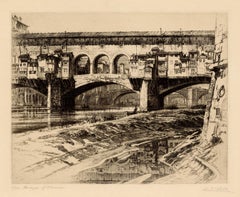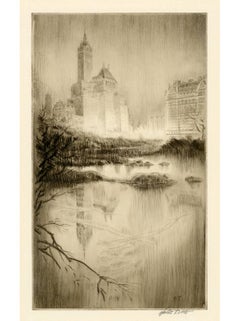Want more images or videos?
Request additional images or videos from the seller
1 of 3
Kerr EbyShipping1932
1932
Price:$700
About the Item
- Creator:Kerr Eby (1890 - 1946, American)
- Creation Year:1932
- Dimensions:Height: 8.38 in (21.29 cm)Width: 17.25 in (43.82 cm)
- Medium:
- Movement & Style:
- Period:
- Condition:
- Gallery Location:Myrtle Beach, SC
- Reference Number:Seller: 1035951stDibs: LU53234386882
Kerr Eby
Kerr Eby was born in 1890 in Tokyo, Japan, the son of Methodist missionaries from Canada. Returning to that country when he was three, Eby grew up studying art, which his parents encouraged, as his mother came from a family of prominent artists. Harold Kerr Eby was born to Canadian Methodist missionaries in Tokyo, Japan, on October 19, 1889. At the age of three his family moved to Vancouver, B.C. and by the time he was twelve, he had lived in Vancouver, Kingston, Toronto and Bracebridge. He worked as a 'printer's devil' on the Bracebridge paper, and at fifteen he took his savings and moved to New York with the dream of becoming an artist After graduating from high school in 1907, Eby moved to New York City to study art, first at the Pratt Institute, and later at the Art Students League.. He enrolled in art classes at Pratt Institute while working for a lithographic firm earning $4.00 a week. His pay barely covered his room and drawing supplies. Within a year, life became desperate for the young artist. Starving and feeling defeated, he left in the spring for home in Canada and was employed by a surveying party in Northern Ontario. While in this northern wilderness, Eby regained his dream of becoming an artist, and in his spare time he started to draw his surroundings. By fall he had saved enough money to return to New York. He attended night classes at the Art Students League while working for another lithographic firm. He spent several more summers surveying in Northern Ontario before he was able to make a living as an illustrator. During this period he formed a number of influential friendships with major artists such as John Henry Twachtman and Childe Hassam and joined a summer artists' colony founded by them at Cos Cob, Connecticut. He supported himself by working as a magazine illustrator and at the American Lithographic Company. Through study and practice, Eby refined both his drawing and printing techniques. Eby was an Associate of the National Academy NA (1930); National Academy of Design (1934); Society of American Etchers; Chicago Society of Etchers; Philadelphia Society of Etchers; National Institute of Arts and Letters. Kerr Eby's work can be found in these collections of the Library of Congress, The Fine Arts Museums of San Francisco, Harvard Art Museums, New York Public Library, Navy Art Collection.
About the Seller
5.0
Recognized Seller
These prestigious sellers are industry leaders and represent the highest echelon for item quality and design.
Platinum Seller
Premium sellers with a 4.7+ rating and 24-hour response times
Established in 1995
1stDibs seller since 2016
320 sales on 1stDibs
Typical response time: 1 hour
Associations
International Fine Print Dealers Association
Authenticity Guarantee
In the unlikely event there’s an issue with an item’s authenticity, contact us within 1 year for a full refund. DetailsMoney-Back Guarantee
If your item is not as described, is damaged in transit, or does not arrive, contact us within 7 days for a full refund. Details24-Hour Cancellation
You have a 24-hour grace period in which to reconsider your purchase, with no questions asked.Vetted Professional Sellers
Our world-class sellers must adhere to strict standards for service and quality, maintaining the integrity of our listings.Price-Match Guarantee
If you find that a seller listed the same item for a lower price elsewhere, we’ll match it.Trusted Global Delivery
Our best-in-class carrier network provides specialized shipping options worldwide, including custom delivery.You May Also Like
Lido (Venice)
By Otto Henry Bacher
Located in Fairlawn, OH
Lido (Venice)
Etching on chine collee, 1880
Part of the artist's "Venice Set"
Signed upper right in plate :Otto H Bacher" (see photo)
Signed with the estate stamp, Lugt 2002 recto lower right beneath image. (see photo)
Created October 20, 1880
Reference: Andrew Venice No. 29
Provenance: Estate of the Artist
Otto H. Bacher (1856-1909)
Otto Henry Bacher was born in Cleveland, Ohio, to a family of German descent. He first studied art at the age of sixteen with local genre trompe l'oeil still-life artist, DeScott Evans. Although he studied with Evans for less than one year, Bacher's early work, comprised mainly of still lifes, betrays Evans's influence. After a short period in Philadelphia, where he studied at the Pennsylvania Academy of the Fine Arts, Bacher returned to Cleveland and met Willis Seaver Adams, an artist from Springfield, Massachusetts, who had just recently arrived upon the Cleveland art scene. Soon the two artists were rooming together. Adams was instrumental in the founding of the Cleveland Art Club, as well as the establishment of the Cleveland Academy of the Fine Arts, to the board of which Adams had Bacher appointed. Also during this time, Bacher began to learn the process of etching from local etcher and landscape painter Sion Longley Wenban.
In 1878, Bacher and Adams left for Europe. After stopping briefly in Scotland, Bacher went on to Munich, where he enrolled at the Royal Academy. He quickly tired of the rigors of the academy, and soon he was studying with Cincinnati artist Frank Duveneck, the prime American exponent of the Munich School. In 1879, Bacher made a trip to Florence with Duveneck as one of the celebrated "Duveneck Boys." Early the following year, the group proceeded to Venice, where Bacher and several other artists established studios in the Casa Jankovitz.
By this time an avid printmaker, Bacher had his etching press sent from Muni ch, and it was in his Venice studio that he taught Duveneck the rudiments of etching. Soon Bacher, Duveneck, and other members of the Duveneck circle were experimenting in printmaking. Among the group's contributions were some of the first American examples of monotypes, which they called "Bachertypes" because they were printed using Bacher's press.
It was also in Venice that Bacher met the venerable American expatriate artist, James McNeill Whistler. On learning of Bacher's press and his collection of etchings by Rembrandt, Whistler made himself a regular visitor to Bacher's studio, and he eventually took his own room in the Casa Jankovitz. Bacher spent much of the rest of 1880 with Whistler, the two artists sharing etching techniques. From Whistler, Bacher learned tone and line graduation; from Bacher, Whistler learned his etching techniques, including better ways of using the acid bath which produced less tedious and more efficient work. Bacher visited Whistler occasionally in the years that followed, and in 1908 he published With Whistler in Venice, his famous recollections of his time with the great artist.
Bacher spent the next two years traveling extensively throughout Italy, with Venice as the center of his operations, and he produced a number of important etchings of Italian subjects. Bacher sent several of these works to America in 1881 to be included in the Society of American artists exhibition that year, and had a similar group of works shown at the Royal Society of Painter-Etchers' first exhibition at the Hanover Gallery in London. Following the exhibition, Bacher, along with several other of the American contributors, was elected a Fellow of the Society. Bacher collected twelve of his etchings of Venetian subjects and sold them in bound volumes through his New York dealer, Frederick Keppel.
Bacher returned to Cleveland in January 1883 as a fully cosmopolitan artist. He set up a lavish studio furnished with exotic items and objets-d'art he had collected on his travels, and began to hold art classes as a means to supplement his income. He soon joined with Joseph De Camp in forming a summer sketch class in Richfield, Ohio. Bacher and De Camp also planned the Cleveland Room for a major loan exhibition in Detroit that year. During this period, Bacher increasingly painted in oil, and he began to produce sun-dappled canvases in an impressionistic mode.
Unable to sell any paintings from this early period, however, Bacher left Cleveland for Paris in 1885, where he planned to undertake further studies. Stopping first in London to visit Whistler, Bacher stayed only briefly in Paris before heading to Venice, where he spent the remainder of the year. In January 1886, Bacher returned to Paris and enrolled at the Académie Julian, and also entered the atelier of Emile-Auguste Carolus-Duran. The life of the student seems never to have suited Bacher, as he stayed in Paris only through June, before departing again for Venice. For the next six months he, Robert Blum, and Charles Ulrich...
Category
1880s American Impressionist Prints and Multiples
Materials
Etching
Brittany Landscape with Figure
By Louis Oscar Griffith
Located in Fairlawn, OH
Brittany Landscape with Figure
Etching & color aquatint, c. 1920
Signed lower right (see photo)
Numbered lower left: "No. 21" (see photo)
An early color etching by the artist, based ...
Category
1920s American Impressionist Landscape Prints
Materials
Aquatint
Desolation, S.C. or Deserted Cabins, Beauford, S.C.
By Louis Oscar Griffith
Located in Fairlawn, OH
Desolation, S.C. or Deserted Cabins, Beauford, S.C.
Etching & Aquatint, c. 1930
Signed by the artist in pencil lower right (see photo)
Annotated "Trial Proof" in pencil lower left corner of sheet
Provenance: Estate of the artist
By decent
Note: An impression of this image is in the collection of the Greenville County Museum of Art, Greenville, South Carolina
Condition: Excellent
Plate/Image size: 8 x 9 3/4 inches
Sheet size: 12 7/8 x 15 inches
Louis Oscar Griffith
(1875-1956)
Born in Greencastle, Indiana, Griffith grew up in Dallas, Texas where Texas artist and teacher Charles Franklin Reaugh recognized young “Griff’s” artistic talent. At age 18, Griffith moved to St. Louis where he attended the St. Louis School of Fine Arts.
In 1895, he moved to Chicago where he worked making color prints for the firm Barnes and Crosby. He attended the Art Institute of Chicago and during a brief stay in New York, the National Academy of Design. A successful commercial artist with a studio in the Chicago Loop...
Category
1930s American Impressionist Landscape Prints
Materials
Aquatint
$1,800
H 8 in W 9.75 in
The Punter
By Frank Benson
Located in New York, NY
A superb, richly-inked impression of this etching. Edition of 150. Signed in pencil, lower left.
Category
1920s American Impressionist Abstract Prints
Materials
Etching
The Rialto
By James Abbott McNeill Whistler
Located in New York, NY
A superb, richly-inked impression of this etching and drypoint, printed in dark brownish black on antique cream laid paper. Second state (of 3). Edition of approximately 30. Signed w...
Category
Late 19th Century American Impressionist Landscape Prints
Materials
Drypoint, Etching
Earl Horter, (European Fountain)
By Earl Horter
Located in New York, NY
Signed in pencil. A European town square with fountain and tower.
Category
Early 20th Century American Impressionist Landscape Prints
Materials
Etching
Longs Peak, Estes Park, Colorado, No. 2, Original 1920s Aquatint
By George Elbert Burr
Located in Denver, CO
This original vintage color aquatint etching captures the breathtaking beauty of Longs Peak and Mount Meeker, as seen from Rocky Mountain National Park near Estes Park, Colorado. Cre...
Category
1920s American Impressionist Landscape Prints
Materials
Aquatint
$1,250
H 14.75 in W 17.25 in D 0.75 in
Landscape with Horses.
By James Abbott McNeill Whistler
Located in Storrs, CT
Kennedy catalog 36 state ii; Glasgow 45 state ii. Image: 4 7/8 x 7 3/4 (sheet 6 7/8 x 9 5/8).The Glasgow catalog records 32 known impressions. A scarce early etching -- there was no ...
Category
Mid-19th Century American Impressionist Landscape Prints
Materials
Drypoint, Etching
$3,000 Sale Price
36% Off
H 4.88 in W 7.75 in D 0.5 in
"Birmingham Meeting House"
By Daniel Garber
Located in Lambertville, NJ
Jim’s of Lambertville Fine Art Gallery is proud to present this piece by Daniel Garber (1880 - 1958).
One of the two most important and, so far, the most valuable of the New Hope Sc...
Category
1930s American Impressionist Landscape Prints
Materials
Etching
"Spring Valley Willows"
By Daniel Garber
Located in Lambertville, NJ
Jim’s of Lambertville Fine Art Gallery is proud to present this piece by Daniel Garber (1880 - 1958).
One of the two most important and, so far, the most valuable of the New Hope School Painters, Daniel Garber was born on April 11, 1880, in North Manchester, Indiana. At the age of seventeen, he studied at the Art Academy of Cincinnati with Vincent Nowottny. Moving to Philadelphia in 1899, he first attended classes at the "Darby School," near Fort Washington; a summer school run by Academy instructors Anshutz and Breckenridge. Later that year, he enrolled at the Pennsylvania Academy of the Fine Arts. His instructors at the Academy included Thomas Anshutz, William Merritt Chase and Cecilia Beaux. There Garber met fellow artist Mary Franklin while she was posing as a model for the portrait class of Hugh Breckenridge. After a two year courtship, Garber married Mary Franklin on June 21, 1901.
In May 1905, Garber was awarded the William Emlen Cresson Scholarship from the Pennsylvania Academy, which enabled him to spend two years for independent studies in England, Italy and France. He painted frequently while in Europe, creating a powerful body of colorful impressionist landscapes depicting various rural villages and farms scenes; exhibiting several of these works in the Paris Salon.
Upon his return, Garber began to teach Life and Antique Drawing classes at the Philadelphia School of Design for Women in 1907. In the summer of that same year, Garber and family settled in Lumbertville, Pennsylvania, a small town just north of New Hope. Their new home would come to be known as the "Cuttalossa," named after the creek which occupied part of the land. The family would divide the year, living six months in Philadelphia at the Green Street townhouse while he taught, and the rest of the time in Lambertville. Soon Garber’s career would take off as he began to receive a multitude of prestigious awards for his masterful Pennsylvania landscapes. During the fall of 1909, he was offered a position to teach at the Pennsylvania Academy as an assistant to Thomas Anshutz. Garber became an important instructor at the Academy, where he taught for forty-one years.
Daniel Garber painted masterful landscapes depicting the Pennsylvania and New Jersey countryside surrounding New Hope. Unlike his contemporary, Edward Redfield, Garber painted with a delicate technique using a thin application of paint. His paintings are filled with color and light projecting a feeling of endless depth. Although Like Redfield, Garber painted large exhibition size canvases with the intent of winning medals, and was extremely successful doing so, he was also very adept at painting small gem like paintings. He was also a fine draftsman creating a relatively large body of works on paper, mostly in charcoal, and a rare few works in pastel. Another of Garber’s many talents was etching. He created a series of approximately fifty different scenes, most of which are run in editions of fifty or less etchings per plate.
Throughout his distinguished career, Daniel Garber was awarded some of the highest honors bestowed upon an American artist. Some of his accolades include the First Hallgarten Prize from the National Academy in 1909, the Bronze Medal at the International Exposition in Buenos Aires in 1910, the Walter Lippincott Prize from the Pennsylvania Academy and the Potter Gold Medal at the Art Institute of Chicago in 1911, the Second Clark Prize and the Silver Medal from the Corcoran Gallery of Art for “Wilderness” in 1912, the Gold Medal from the Panama-Pacific Exposition in San Francisco of 1915, the Second Altman Prize in1915, the Shaw prize in 1916, the First Altman Prize in 1917, the Edward Stotesbury Prize in1918, the Temple Gold Medal, in 1919, the First William A...
Category
1940s American Impressionist Landscape Prints
Materials
Etching
More From This Seller
View All'Black Hawk Country' — Early 20th-Century American Impressionism
Located in Myrtle Beach, SC
Ralph M. Pearson, 'Black Hawk Country', etching, second state, edition not stated, 1912. Signed, and titled in pencil. Inscribed 'Rock River Series Second...
Category
1910s American Impressionist Landscape Prints
Materials
Etching
'Bridges of Florence' — Firenze Impressionism
Located in Myrtle Beach, SC
Alonzo C. Webb, 'Bridges of Florence', etching, 1929, edition 100. Signed and titled in pencil. Signed and dated in the plate, lower left. A superb, richly-inked impression, in warm ...
Category
1920s American Impressionist Figurative Prints
Materials
Etching
Broad Street (Wall Street)
By Bror Julius Olsson Nordfeldt
Located in Myrtle Beach, SC
B.J.O. Nordfeldt, 'Broad Street (Wall Street)', etching, edition not stated, c. 1915. Signed in pencil. A superb impression, with rich burr, selectively wiped plate tone, and inky plate edges, on cream wove paper; the full sheet with margins (3/4 to 1 1/4 inches), in excellent condition. Printed by the artist. Matted to museum standards, unframed.
Impressions of this work are in the permanent collections of the Fine Arts Museums of San Francisco, Princeton University, Smithsonian American Art Museum.
A view looking down Broad Street past the New York Stock Exchange Building on the right with the columned Federal Hall...
Category
1910s American Impressionist Landscape Prints
Materials
Etching
The Plaza, Sunset Glow
By Walter Tittle
Located in Myrtle Beach, SC
'The Plaza, Sunset Glow', drypoint, c. 1920s, edition not stated. Signed in pencil and initialed in the plate, lower right. Titled 'The Plaza, Sunset' and annotated 'no. 165' in ink, in the bottom left sheet corner. A superb, luminous impression in dark brown ink, with selectively wiped plate tone; on cream wove paper; the full sheet with margins (1 to 2 1/4 inches). Pale tape stains on the top sheet edge, recto, well away from the image, otherwise in excellent condition. Matted to museum standards, unframed.
A view across 'The Pond' in New York City's Central Park, toward Grand Army Plaza...
Category
1920s American Impressionist Landscape Prints
Materials
Drypoint
'Grand Central, Night' — 1920s New York City Realism
By Walter Tittle
Located in Myrtle Beach, SC
Walter Tittle, 'Grand Central Night', drypoint, edition not stated, c. 1920s. Signed in pencil. Titled, and annotated '36.00' and with the inventory numb...
Category
1920s American Impressionist Landscape Prints
Materials
Drypoint
Hungerford Bridge, London
By Kerr Eby
Located in Myrtle Beach, SC
Kerr Eby 'Hungerford Bridge, London', etching and sandpaper ground, 1929, edition 90, Giardina 144. Signed, titled, and annotated 'Ed 90' in pencil. Signed again in the bottom right sheet corner. A fine, atmospheric impression, with delicate plate tone, on cream wove paper; the full sheet with margins (1 1/2 to 1 5/8 inches), in excellent condition. Matted to museum standards, unframed.
Hungerford Foot Bridge spans the River Thames in London, between Westminster Bridge and Waterloo Bridge. Eby visited Great Britain and France during 1924 and 1925.
Impressions of this work are in the permanent collection of the following institutions: American Academy and Institute of Arts and Letters, Arizona State University, Boston Public Library, Davison Art Center (Wesleyan University), Herbert F, Johnson Museum of Art, Huntington Museum of Art, Hood Museum of Art (Dartmouth College), Metropolitan Museum of Art, Montgomery Museum of Fine Arts, National Museum of American Art, New York Public Library, Smithsonian Museum of American Art.
ABOUT THE ARTIST
Kerr Eby was born in 1890 in Tokyo, Japan, the son of Methodist missionaries from Canada. The family returned to Vancouver when Eby was only three, and he grew up studying art encouraged by his parents as his mother was from a family of prominent artists. By age twelve, he had lived in Vancouver, Kingston, Toronto and Bracebridge where he found work as a ‘printer’s devil’ on the local Bracebridge newspaper.
After graduating from high school in 1907, Eby moved to New York City to study art, first at the Pratt Institute, and later at the Art Students League. He enrolled in art classes at Pratt Institute while working for a lithographic firm earning $4.00 a week. His pay barely covered his room and drawing supplies. Within a year, starving and feeling defeated, he returned to Canada and was employed by a surveying party in Northern Ontario. Eby gradually regained his dream of becoming an artist, and in his spare time, he began to draw the surrounding wilderness landscapes. By fall he had returned to New York to attend night classes at the Art Students League while working for another lithographic firm. He spent several more summers surveying in Northern Ontario before he was able to make a living as an illustrator. During this period he formed several friendships with influential artists including John Henry Twachtman and Childe Hassam and joined a summer artists' colony founded by them at Cos Cob, Connecticut. He supported himself by working as a magazine illustrator and at the American Lithographic Company. Through diligent study and practice, Eby refined both his drawing and printmaking techniques.
In 1917, when the United States entered World War I, Eby joined the U.S. Army. Failing to obtain a commission as an artist, he was assigned first to ambulance duty and later as a sergeant in the 40th Engineers in France. He spent most of WWI on the front line as a camouflager of the field artillery ‘big guns”. On his time off duty, he would sketch everything he witnessed, from the explosive big guns and men in action to the dead soldiers in the field. He sent the drawings home each week, and upon his return from the war, they became the basis for his first successful group of etchings. He continued creating his war-related prints throughout the 1920s and '30s as his work became widely exhibited Frederick Keppel, the renowned print dealer and a relative of Eby, became the exclusive agent for many of his print editions.
With another global conflict beginning in the mid-1930s, Eby wanted to show the world the true face of war...
Category
1920s Impressionist Landscape Prints
Materials
Etching




